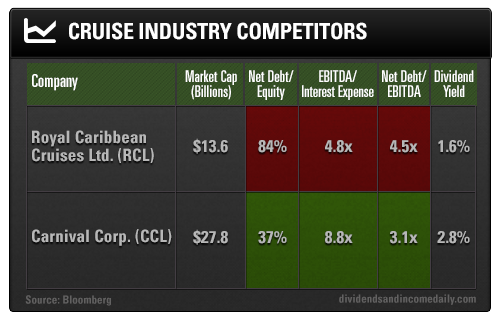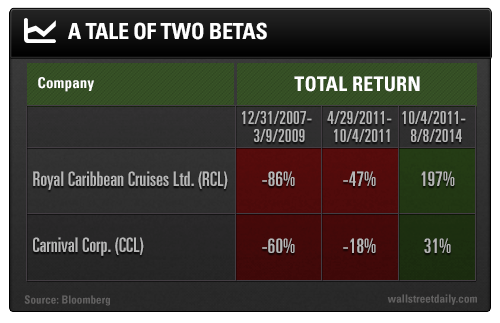Last week, I revealed how weaker firms have been able to outperform companies with stronger balance sheets.
I also noted that the trend is beginning to reverse course – a development that could lead to disaster for investors caught unaware.
So today, let’s zero in on an opportunity that takes full advantage of this reversal.
The Cruise Industry Oligopoly
The capital-intensive nature of the cruise business discourages new entrants and has simplified the competitive landscape.
Therefore, the industry is essentially an oligopoly.
Carnival (NYSE:CCL) is the largest cruise operator in the world, with more than 100 ships in service. Royal Caribbean Cruises Ltd. (NYSE:RCL) is the second largest with 40 ships.
Combined, these two companies control around 75% of the global cruise ship market.
After breaking down their financials, however, it doesn’t take long to realize the major difference between these two companies…

Carnival is larger, with a slower growth rate and a higher dividend yield. It also has a far lower debt load, as measured by the net debt-to-equity ratio.
Plus, Royal Caribbean’s earnings before interest, depreciation, and amortization (EBITDA) covers less of its interest expense than Carnival’s EBITDA. (A lower EBITDA-to-interest expense ratio indicates more burdensome interest payments.)
In short, Carnival clearly possesses the stronger balance sheet.
Accordingly, Standard & Poor’s gives Carnival a BBB+ rating, which is investment grade. Royal Caribbean is rated BB, which is high yield, otherwise known as “junk.”
That being said, shares of Royal Caribbean have recently trounced Carnival stock. Check out its dramatic outperformance since October 2011.

Of course, financial leverage has a significant impact on the volatility (risk) of a company’s stock price. This effect on beta (systematic risk) is illustrated in the table above.
Companies with high debt levels like Royal Caribbean have had an amazing run just as they did during other credit cycles in the past.
Yet during the financial crisis, RCL was crushed.
The fear of bankruptcy was palpable for many highly levered companies. RCL also fell much harder than CCL during the market swoon in late 2011.
Granted, Carnival has had several recent ship accidents, such as the Costa Concordia disaster. But the company has weathered these incidents, and there doesn’t seem to be any lasting impact on cruise bookings.
Luckily, most people (and investors, in particular) have short memories.
Prepare for Rough Seas Ahead
Now, it’s time to batten down the hatches…
Investors need to make sure the companies in their portfolios have strong balance sheets with low net debt levels and high interest expense coverage.
For the traders out there, a pairs trade between CCL and RCL is worth a look.
A pairs trade is a strategy of matching a long position in one stock with a short position in another, preferably involving two companies in the same industry.
The idea is to pick securities that are highly correlated, or tend to move up and down together.
This way, we can effectively create a near-market-neutral position, or one that isn’t overly dependent upon the broader market rising or falling. It also allows us to limit our exposure to the cruise industry, which is very cyclical.
Ideally, we want a strong balance sheet and a weak balance sheet (or relatively weaker) to take advantage of a move to safety.
There are many other examples of this type of opportunity, but long CCL/short RCL is a perfect example of a pairs trade that will likely benefit from rough seas ahead.
Safe (and high-yield) investing,
Alan Gula, CFA
